Women in Islam: Examining Modesty, Harassment, and Rights in Egypt
VerifiedAdded on 2023/04/17
|7
|1776
|418
Essay
AI Summary
This essay critically examines the position of women in Egyptian Islamic society, focusing on the controversial issue of modesty and its impact on sexual harassment. It argues that the Islamic expectation for women to observe modesty through veiling, intended to protect them from sexual predato...
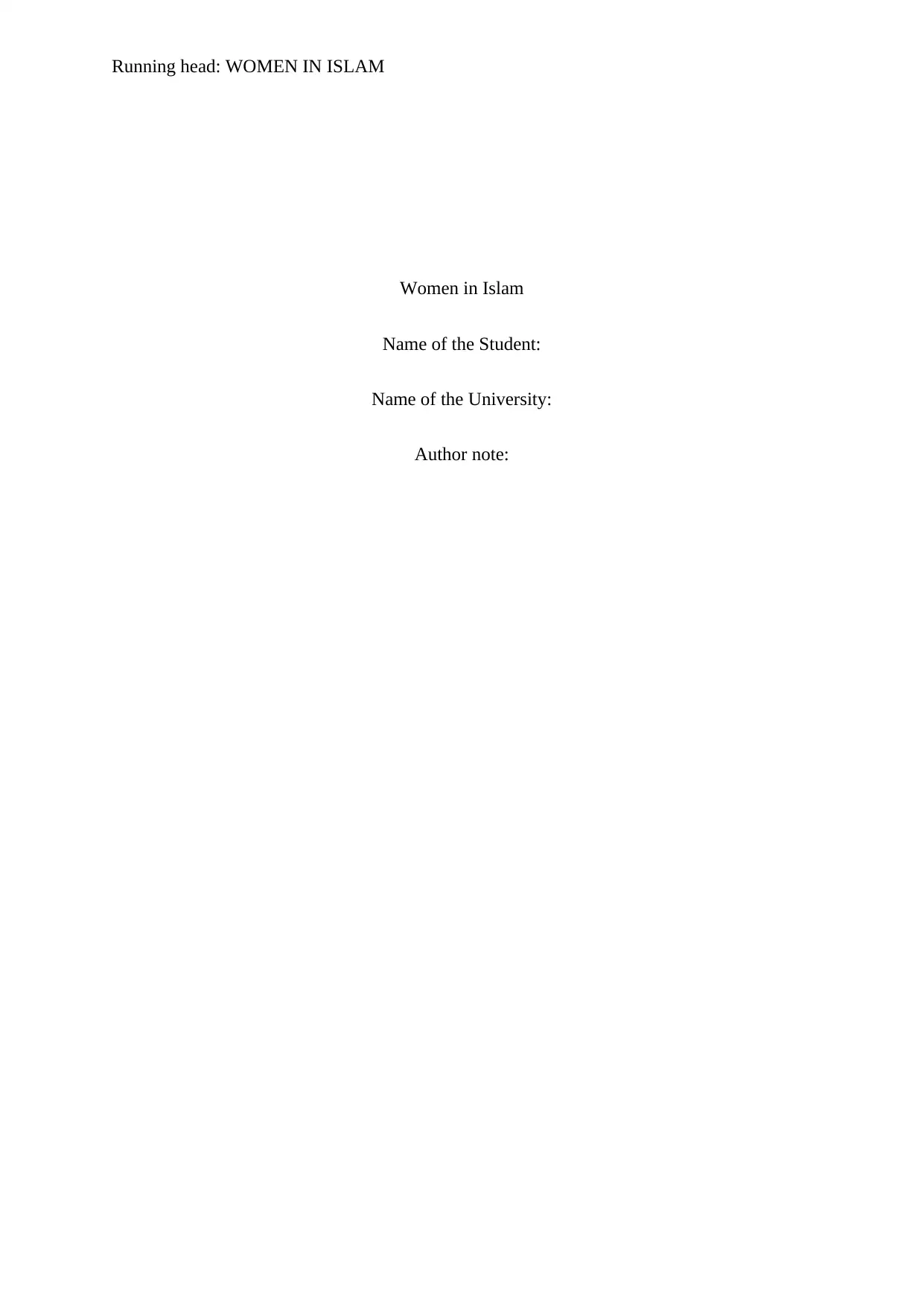
Running head: WOMEN IN ISLAM
Women in Islam
Name of the Student:
Name of the University:
Author note:
Women in Islam
Name of the Student:
Name of the University:
Author note:
Paraphrase This Document
Need a fresh take? Get an instant paraphrase of this document with our AI Paraphraser
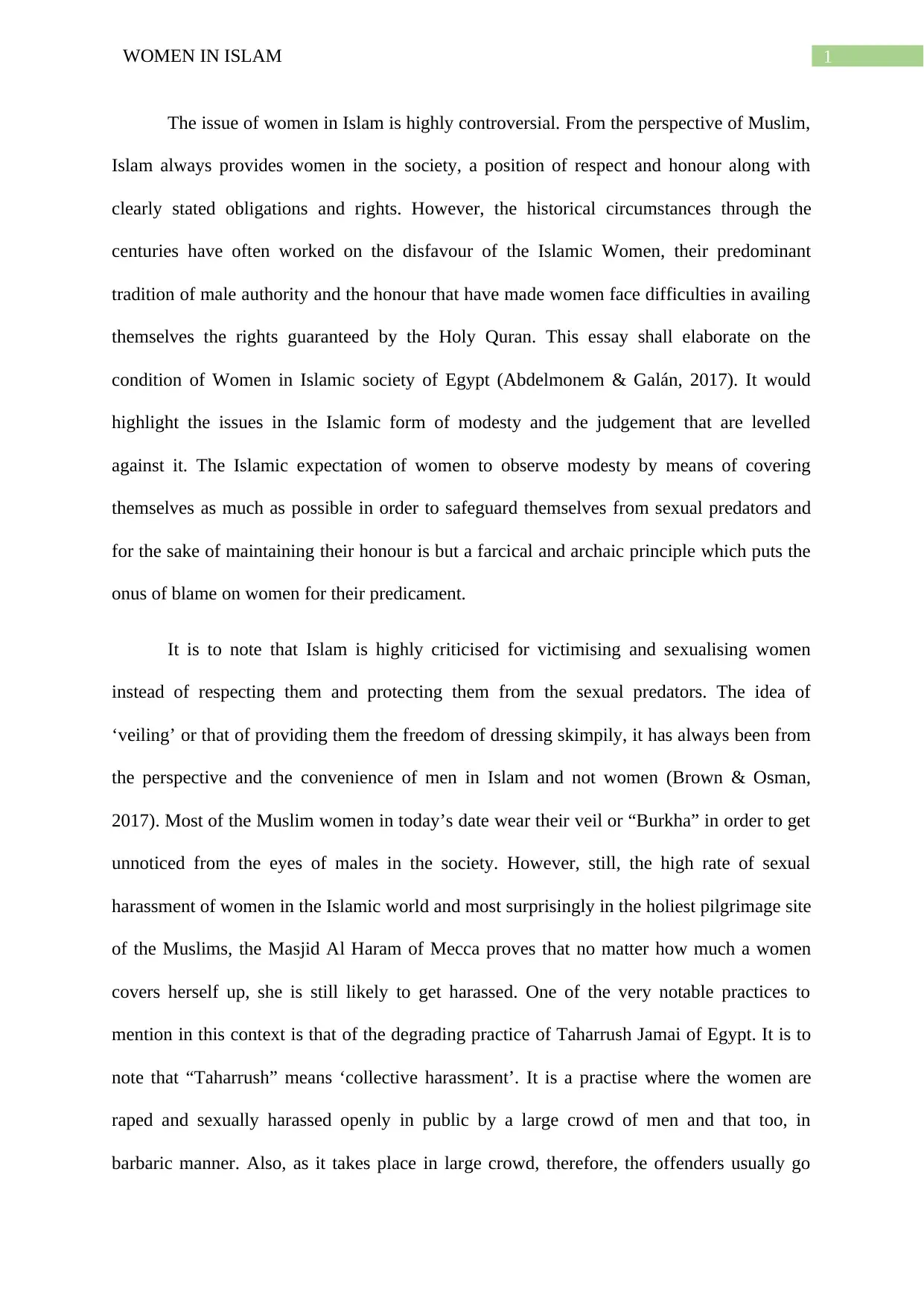
1WOMEN IN ISLAM
The issue of women in Islam is highly controversial. From the perspective of Muslim,
Islam always provides women in the society, a position of respect and honour along with
clearly stated obligations and rights. However, the historical circumstances through the
centuries have often worked on the disfavour of the Islamic Women, their predominant
tradition of male authority and the honour that have made women face difficulties in availing
themselves the rights guaranteed by the Holy Quran. This essay shall elaborate on the
condition of Women in Islamic society of Egypt (Abdelmonem & Galán, 2017). It would
highlight the issues in the Islamic form of modesty and the judgement that are levelled
against it. The Islamic expectation of women to observe modesty by means of covering
themselves as much as possible in order to safeguard themselves from sexual predators and
for the sake of maintaining their honour is but a farcical and archaic principle which puts the
onus of blame on women for their predicament.
It is to note that Islam is highly criticised for victimising and sexualising women
instead of respecting them and protecting them from the sexual predators. The idea of
‘veiling’ or that of providing them the freedom of dressing skimpily, it has always been from
the perspective and the convenience of men in Islam and not women (Brown & Osman,
2017). Most of the Muslim women in today’s date wear their veil or “Burkha” in order to get
unnoticed from the eyes of males in the society. However, still, the high rate of sexual
harassment of women in the Islamic world and most surprisingly in the holiest pilgrimage site
of the Muslims, the Masjid Al Haram of Mecca proves that no matter how much a women
covers herself up, she is still likely to get harassed. One of the very notable practices to
mention in this context is that of the degrading practice of Taharrush Jamai of Egypt. It is to
note that “Taharrush” means ‘collective harassment’. It is a practise where the women are
raped and sexually harassed openly in public by a large crowd of men and that too, in
barbaric manner. Also, as it takes place in large crowd, therefore, the offenders usually go
The issue of women in Islam is highly controversial. From the perspective of Muslim,
Islam always provides women in the society, a position of respect and honour along with
clearly stated obligations and rights. However, the historical circumstances through the
centuries have often worked on the disfavour of the Islamic Women, their predominant
tradition of male authority and the honour that have made women face difficulties in availing
themselves the rights guaranteed by the Holy Quran. This essay shall elaborate on the
condition of Women in Islamic society of Egypt (Abdelmonem & Galán, 2017). It would
highlight the issues in the Islamic form of modesty and the judgement that are levelled
against it. The Islamic expectation of women to observe modesty by means of covering
themselves as much as possible in order to safeguard themselves from sexual predators and
for the sake of maintaining their honour is but a farcical and archaic principle which puts the
onus of blame on women for their predicament.
It is to note that Islam is highly criticised for victimising and sexualising women
instead of respecting them and protecting them from the sexual predators. The idea of
‘veiling’ or that of providing them the freedom of dressing skimpily, it has always been from
the perspective and the convenience of men in Islam and not women (Brown & Osman,
2017). Most of the Muslim women in today’s date wear their veil or “Burkha” in order to get
unnoticed from the eyes of males in the society. However, still, the high rate of sexual
harassment of women in the Islamic world and most surprisingly in the holiest pilgrimage site
of the Muslims, the Masjid Al Haram of Mecca proves that no matter how much a women
covers herself up, she is still likely to get harassed. One of the very notable practices to
mention in this context is that of the degrading practice of Taharrush Jamai of Egypt. It is to
note that “Taharrush” means ‘collective harassment’. It is a practise where the women are
raped and sexually harassed openly in public by a large crowd of men and that too, in
barbaric manner. Also, as it takes place in large crowd, therefore, the offenders usually go
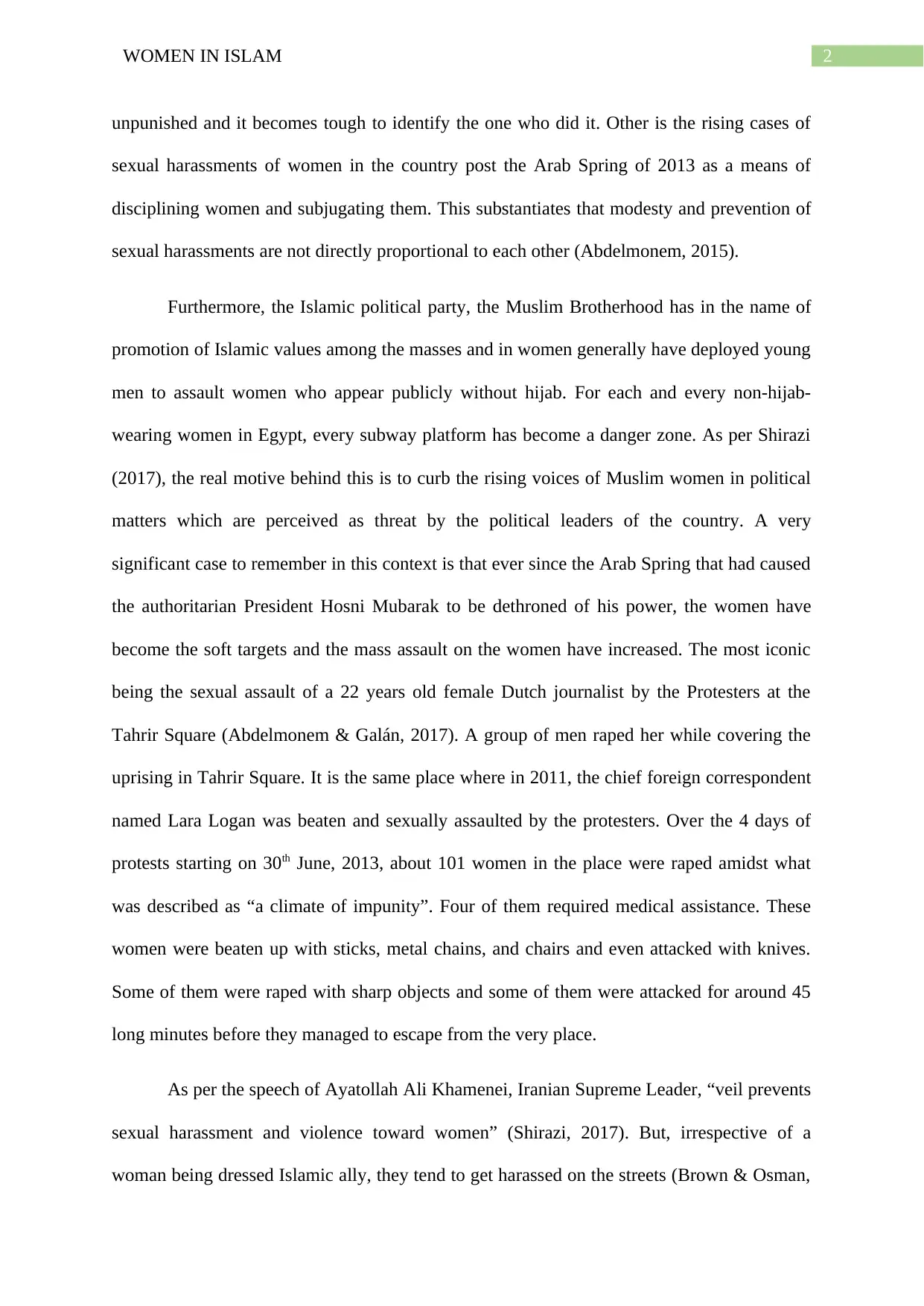
2WOMEN IN ISLAM
unpunished and it becomes tough to identify the one who did it. Other is the rising cases of
sexual harassments of women in the country post the Arab Spring of 2013 as a means of
disciplining women and subjugating them. This substantiates that modesty and prevention of
sexual harassments are not directly proportional to each other (Abdelmonem, 2015).
Furthermore, the Islamic political party, the Muslim Brotherhood has in the name of
promotion of Islamic values among the masses and in women generally have deployed young
men to assault women who appear publicly without hijab. For each and every non-hijab-
wearing women in Egypt, every subway platform has become a danger zone. As per Shirazi
(2017), the real motive behind this is to curb the rising voices of Muslim women in political
matters which are perceived as threat by the political leaders of the country. A very
significant case to remember in this context is that ever since the Arab Spring that had caused
the authoritarian President Hosni Mubarak to be dethroned of his power, the women have
become the soft targets and the mass assault on the women have increased. The most iconic
being the sexual assault of a 22 years old female Dutch journalist by the Protesters at the
Tahrir Square (Abdelmonem & Galán, 2017). A group of men raped her while covering the
uprising in Tahrir Square. It is the same place where in 2011, the chief foreign correspondent
named Lara Logan was beaten and sexually assaulted by the protesters. Over the 4 days of
protests starting on 30th June, 2013, about 101 women in the place were raped amidst what
was described as “a climate of impunity”. Four of them required medical assistance. These
women were beaten up with sticks, metal chains, and chairs and even attacked with knives.
Some of them were raped with sharp objects and some of them were attacked for around 45
long minutes before they managed to escape from the very place.
As per the speech of Ayatollah Ali Khamenei, Iranian Supreme Leader, “veil prevents
sexual harassment and violence toward women” (Shirazi, 2017). But, irrespective of a
woman being dressed Islamic ally, they tend to get harassed on the streets (Brown & Osman,
unpunished and it becomes tough to identify the one who did it. Other is the rising cases of
sexual harassments of women in the country post the Arab Spring of 2013 as a means of
disciplining women and subjugating them. This substantiates that modesty and prevention of
sexual harassments are not directly proportional to each other (Abdelmonem, 2015).
Furthermore, the Islamic political party, the Muslim Brotherhood has in the name of
promotion of Islamic values among the masses and in women generally have deployed young
men to assault women who appear publicly without hijab. For each and every non-hijab-
wearing women in Egypt, every subway platform has become a danger zone. As per Shirazi
(2017), the real motive behind this is to curb the rising voices of Muslim women in political
matters which are perceived as threat by the political leaders of the country. A very
significant case to remember in this context is that ever since the Arab Spring that had caused
the authoritarian President Hosni Mubarak to be dethroned of his power, the women have
become the soft targets and the mass assault on the women have increased. The most iconic
being the sexual assault of a 22 years old female Dutch journalist by the Protesters at the
Tahrir Square (Abdelmonem & Galán, 2017). A group of men raped her while covering the
uprising in Tahrir Square. It is the same place where in 2011, the chief foreign correspondent
named Lara Logan was beaten and sexually assaulted by the protesters. Over the 4 days of
protests starting on 30th June, 2013, about 101 women in the place were raped amidst what
was described as “a climate of impunity”. Four of them required medical assistance. These
women were beaten up with sticks, metal chains, and chairs and even attacked with knives.
Some of them were raped with sharp objects and some of them were attacked for around 45
long minutes before they managed to escape from the very place.
As per the speech of Ayatollah Ali Khamenei, Iranian Supreme Leader, “veil prevents
sexual harassment and violence toward women” (Shirazi, 2017). But, irrespective of a
woman being dressed Islamic ally, they tend to get harassed on the streets (Brown & Osman,
⊘ This is a preview!⊘
Do you want full access?
Subscribe today to unlock all pages.

Trusted by 1+ million students worldwide
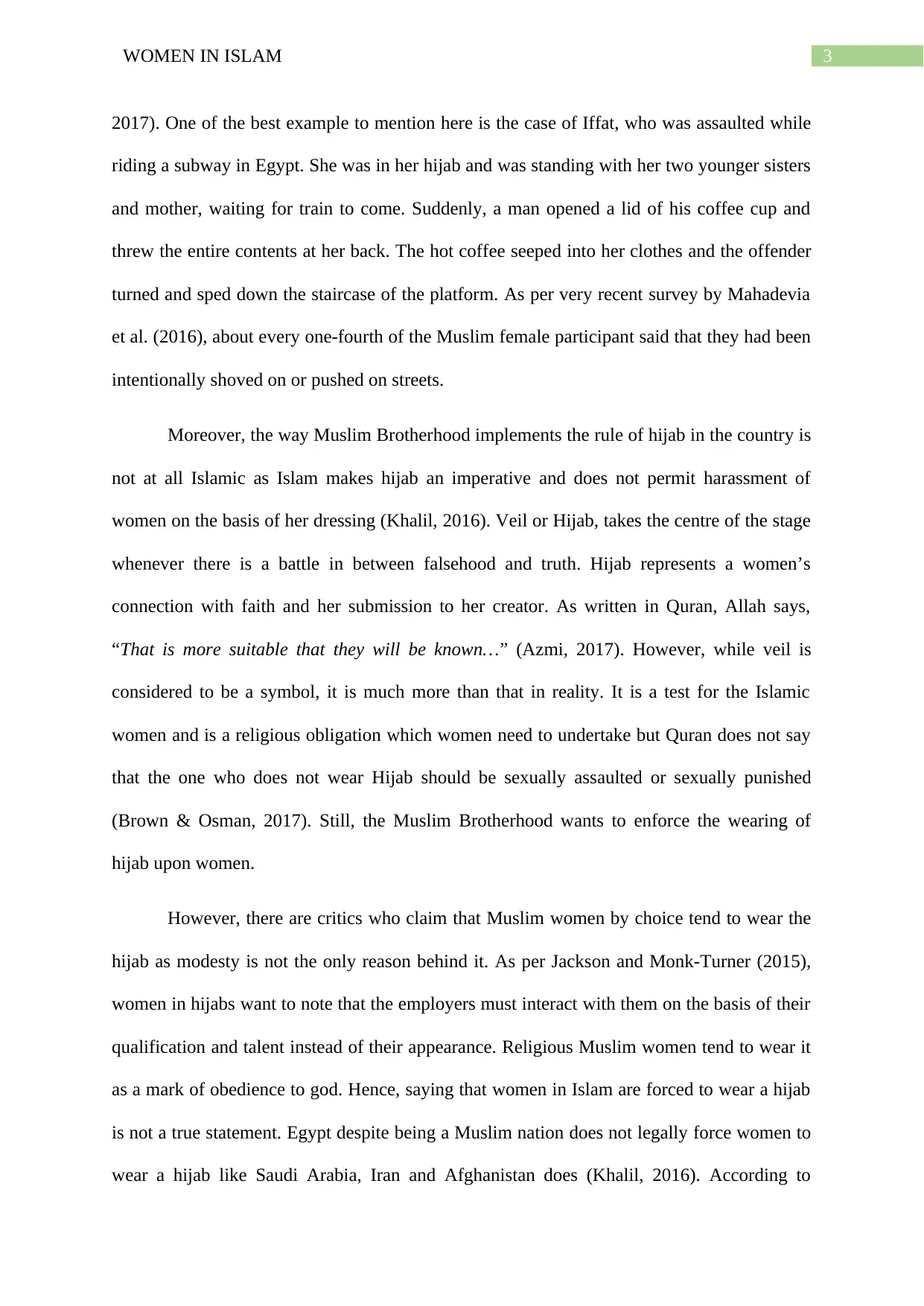
3WOMEN IN ISLAM
2017). One of the best example to mention here is the case of Iffat, who was assaulted while
riding a subway in Egypt. She was in her hijab and was standing with her two younger sisters
and mother, waiting for train to come. Suddenly, a man opened a lid of his coffee cup and
threw the entire contents at her back. The hot coffee seeped into her clothes and the offender
turned and sped down the staircase of the platform. As per very recent survey by Mahadevia
et al. (2016), about every one-fourth of the Muslim female participant said that they had been
intentionally shoved on or pushed on streets.
Moreover, the way Muslim Brotherhood implements the rule of hijab in the country is
not at all Islamic as Islam makes hijab an imperative and does not permit harassment of
women on the basis of her dressing (Khalil, 2016). Veil or Hijab, takes the centre of the stage
whenever there is a battle in between falsehood and truth. Hijab represents a women’s
connection with faith and her submission to her creator. As written in Quran, Allah says,
“That is more suitable that they will be known…” (Azmi, 2017). However, while veil is
considered to be a symbol, it is much more than that in reality. It is a test for the Islamic
women and is a religious obligation which women need to undertake but Quran does not say
that the one who does not wear Hijab should be sexually assaulted or sexually punished
(Brown & Osman, 2017). Still, the Muslim Brotherhood wants to enforce the wearing of
hijab upon women.
However, there are critics who claim that Muslim women by choice tend to wear the
hijab as modesty is not the only reason behind it. As per Jackson and Monk-Turner (2015),
women in hijabs want to note that the employers must interact with them on the basis of their
qualification and talent instead of their appearance. Religious Muslim women tend to wear it
as a mark of obedience to god. Hence, saying that women in Islam are forced to wear a hijab
is not a true statement. Egypt despite being a Muslim nation does not legally force women to
wear a hijab like Saudi Arabia, Iran and Afghanistan does (Khalil, 2016). According to
2017). One of the best example to mention here is the case of Iffat, who was assaulted while
riding a subway in Egypt. She was in her hijab and was standing with her two younger sisters
and mother, waiting for train to come. Suddenly, a man opened a lid of his coffee cup and
threw the entire contents at her back. The hot coffee seeped into her clothes and the offender
turned and sped down the staircase of the platform. As per very recent survey by Mahadevia
et al. (2016), about every one-fourth of the Muslim female participant said that they had been
intentionally shoved on or pushed on streets.
Moreover, the way Muslim Brotherhood implements the rule of hijab in the country is
not at all Islamic as Islam makes hijab an imperative and does not permit harassment of
women on the basis of her dressing (Khalil, 2016). Veil or Hijab, takes the centre of the stage
whenever there is a battle in between falsehood and truth. Hijab represents a women’s
connection with faith and her submission to her creator. As written in Quran, Allah says,
“That is more suitable that they will be known…” (Azmi, 2017). However, while veil is
considered to be a symbol, it is much more than that in reality. It is a test for the Islamic
women and is a religious obligation which women need to undertake but Quran does not say
that the one who does not wear Hijab should be sexually assaulted or sexually punished
(Brown & Osman, 2017). Still, the Muslim Brotherhood wants to enforce the wearing of
hijab upon women.
However, there are critics who claim that Muslim women by choice tend to wear the
hijab as modesty is not the only reason behind it. As per Jackson and Monk-Turner (2015),
women in hijabs want to note that the employers must interact with them on the basis of their
qualification and talent instead of their appearance. Religious Muslim women tend to wear it
as a mark of obedience to god. Hence, saying that women in Islam are forced to wear a hijab
is not a true statement. Egypt despite being a Muslim nation does not legally force women to
wear a hijab like Saudi Arabia, Iran and Afghanistan does (Khalil, 2016). According to
Paraphrase This Document
Need a fresh take? Get an instant paraphrase of this document with our AI Paraphraser
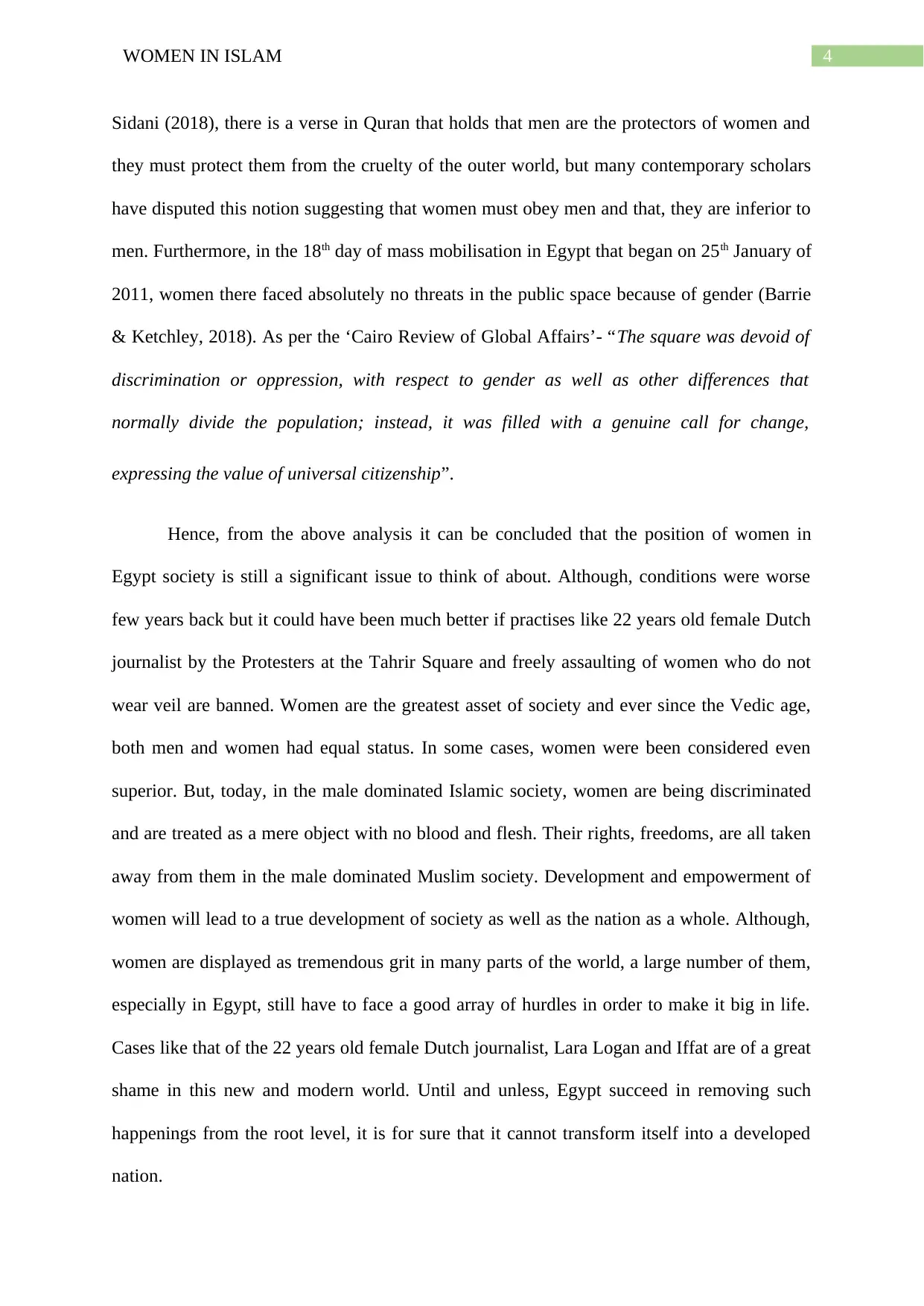
4WOMEN IN ISLAM
Sidani (2018), there is a verse in Quran that holds that men are the protectors of women and
they must protect them from the cruelty of the outer world, but many contemporary scholars
have disputed this notion suggesting that women must obey men and that, they are inferior to
men. Furthermore, in the 18th day of mass mobilisation in Egypt that began on 25th January of
2011, women there faced absolutely no threats in the public space because of gender (Barrie
& Ketchley, 2018). As per the ‘Cairo Review of Global Affairs’- “The square was devoid of
discrimination or oppression, with respect to gender as well as other differences that
normally divide the population; instead, it was filled with a genuine call for change,
expressing the value of universal citizenship”.
Hence, from the above analysis it can be concluded that the position of women in
Egypt society is still a significant issue to think of about. Although, conditions were worse
few years back but it could have been much better if practises like 22 years old female Dutch
journalist by the Protesters at the Tahrir Square and freely assaulting of women who do not
wear veil are banned. Women are the greatest asset of society and ever since the Vedic age,
both men and women had equal status. In some cases, women were been considered even
superior. But, today, in the male dominated Islamic society, women are being discriminated
and are treated as a mere object with no blood and flesh. Their rights, freedoms, are all taken
away from them in the male dominated Muslim society. Development and empowerment of
women will lead to a true development of society as well as the nation as a whole. Although,
women are displayed as tremendous grit in many parts of the world, a large number of them,
especially in Egypt, still have to face a good array of hurdles in order to make it big in life.
Cases like that of the 22 years old female Dutch journalist, Lara Logan and Iffat are of a great
shame in this new and modern world. Until and unless, Egypt succeed in removing such
happenings from the root level, it is for sure that it cannot transform itself into a developed
nation.
Sidani (2018), there is a verse in Quran that holds that men are the protectors of women and
they must protect them from the cruelty of the outer world, but many contemporary scholars
have disputed this notion suggesting that women must obey men and that, they are inferior to
men. Furthermore, in the 18th day of mass mobilisation in Egypt that began on 25th January of
2011, women there faced absolutely no threats in the public space because of gender (Barrie
& Ketchley, 2018). As per the ‘Cairo Review of Global Affairs’- “The square was devoid of
discrimination or oppression, with respect to gender as well as other differences that
normally divide the population; instead, it was filled with a genuine call for change,
expressing the value of universal citizenship”.
Hence, from the above analysis it can be concluded that the position of women in
Egypt society is still a significant issue to think of about. Although, conditions were worse
few years back but it could have been much better if practises like 22 years old female Dutch
journalist by the Protesters at the Tahrir Square and freely assaulting of women who do not
wear veil are banned. Women are the greatest asset of society and ever since the Vedic age,
both men and women had equal status. In some cases, women were been considered even
superior. But, today, in the male dominated Islamic society, women are being discriminated
and are treated as a mere object with no blood and flesh. Their rights, freedoms, are all taken
away from them in the male dominated Muslim society. Development and empowerment of
women will lead to a true development of society as well as the nation as a whole. Although,
women are displayed as tremendous grit in many parts of the world, a large number of them,
especially in Egypt, still have to face a good array of hurdles in order to make it big in life.
Cases like that of the 22 years old female Dutch journalist, Lara Logan and Iffat are of a great
shame in this new and modern world. Until and unless, Egypt succeed in removing such
happenings from the root level, it is for sure that it cannot transform itself into a developed
nation.
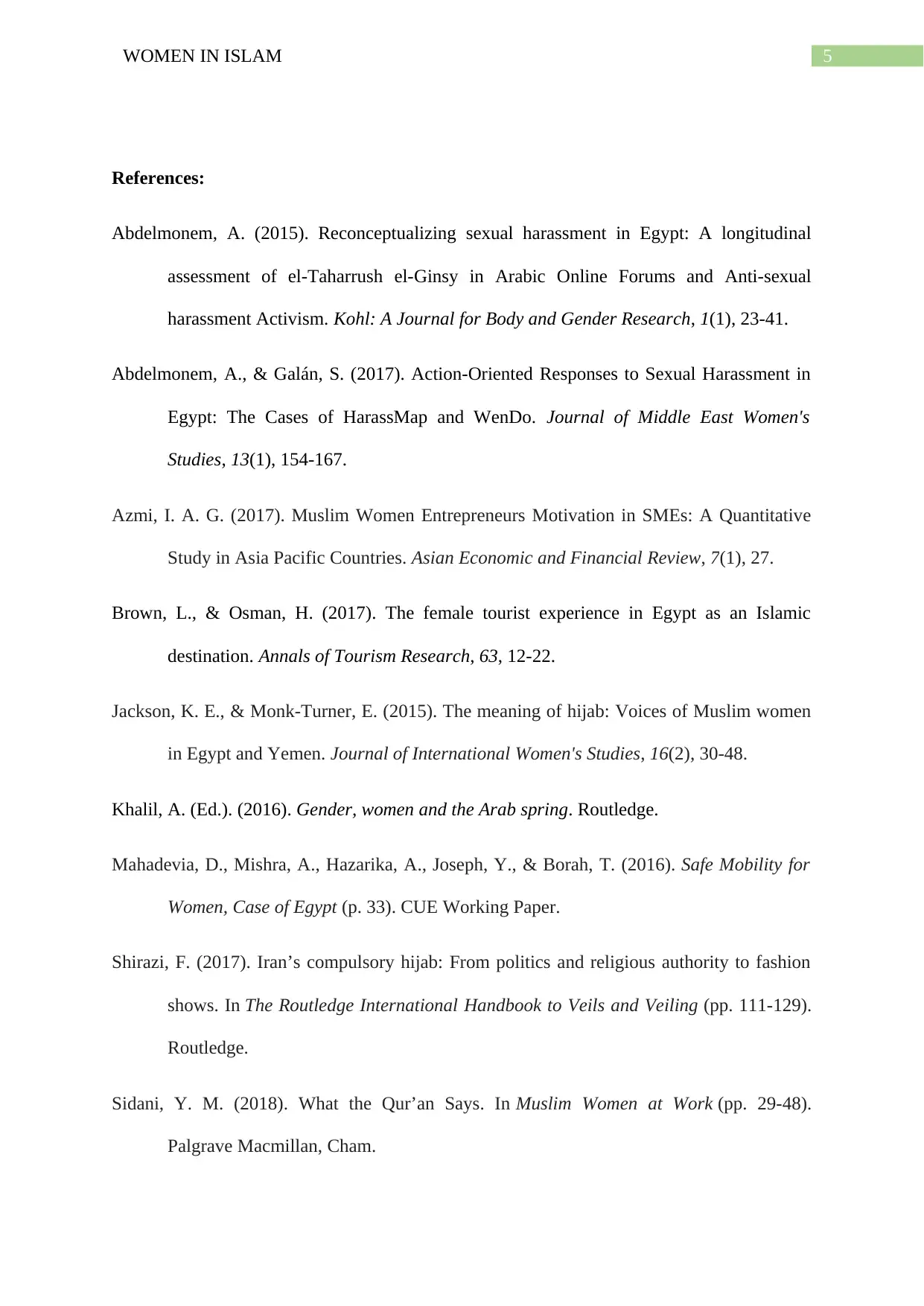
5WOMEN IN ISLAM
References:
Abdelmonem, A. (2015). Reconceptualizing sexual harassment in Egypt: A longitudinal
assessment of el-Taharrush el-Ginsy in Arabic Online Forums and Anti-sexual
harassment Activism. Kohl: A Journal for Body and Gender Research, 1(1), 23-41.
Abdelmonem, A., & Galán, S. (2017). Action-Oriented Responses to Sexual Harassment in
Egypt: The Cases of HarassMap and WenDo. Journal of Middle East Women's
Studies, 13(1), 154-167.
Azmi, I. A. G. (2017). Muslim Women Entrepreneurs Motivation in SMEs: A Quantitative
Study in Asia Pacific Countries. Asian Economic and Financial Review, 7(1), 27.
Brown, L., & Osman, H. (2017). The female tourist experience in Egypt as an Islamic
destination. Annals of Tourism Research, 63, 12-22.
Jackson, K. E., & Monk-Turner, E. (2015). The meaning of hijab: Voices of Muslim women
in Egypt and Yemen. Journal of International Women's Studies, 16(2), 30-48.
Khalil, A. (Ed.). (2016). Gender, women and the Arab spring. Routledge.
Mahadevia, D., Mishra, A., Hazarika, A., Joseph, Y., & Borah, T. (2016). Safe Mobility for
Women, Case of Egypt (p. 33). CUE Working Paper.
Shirazi, F. (2017). Iran’s compulsory hijab: From politics and religious authority to fashion
shows. In The Routledge International Handbook to Veils and Veiling (pp. 111-129).
Routledge.
Sidani, Y. M. (2018). What the Qur’an Says. In Muslim Women at Work (pp. 29-48).
Palgrave Macmillan, Cham.
References:
Abdelmonem, A. (2015). Reconceptualizing sexual harassment in Egypt: A longitudinal
assessment of el-Taharrush el-Ginsy in Arabic Online Forums and Anti-sexual
harassment Activism. Kohl: A Journal for Body and Gender Research, 1(1), 23-41.
Abdelmonem, A., & Galán, S. (2017). Action-Oriented Responses to Sexual Harassment in
Egypt: The Cases of HarassMap and WenDo. Journal of Middle East Women's
Studies, 13(1), 154-167.
Azmi, I. A. G. (2017). Muslim Women Entrepreneurs Motivation in SMEs: A Quantitative
Study in Asia Pacific Countries. Asian Economic and Financial Review, 7(1), 27.
Brown, L., & Osman, H. (2017). The female tourist experience in Egypt as an Islamic
destination. Annals of Tourism Research, 63, 12-22.
Jackson, K. E., & Monk-Turner, E. (2015). The meaning of hijab: Voices of Muslim women
in Egypt and Yemen. Journal of International Women's Studies, 16(2), 30-48.
Khalil, A. (Ed.). (2016). Gender, women and the Arab spring. Routledge.
Mahadevia, D., Mishra, A., Hazarika, A., Joseph, Y., & Borah, T. (2016). Safe Mobility for
Women, Case of Egypt (p. 33). CUE Working Paper.
Shirazi, F. (2017). Iran’s compulsory hijab: From politics and religious authority to fashion
shows. In The Routledge International Handbook to Veils and Veiling (pp. 111-129).
Routledge.
Sidani, Y. M. (2018). What the Qur’an Says. In Muslim Women at Work (pp. 29-48).
Palgrave Macmillan, Cham.
⊘ This is a preview!⊘
Do you want full access?
Subscribe today to unlock all pages.

Trusted by 1+ million students worldwide
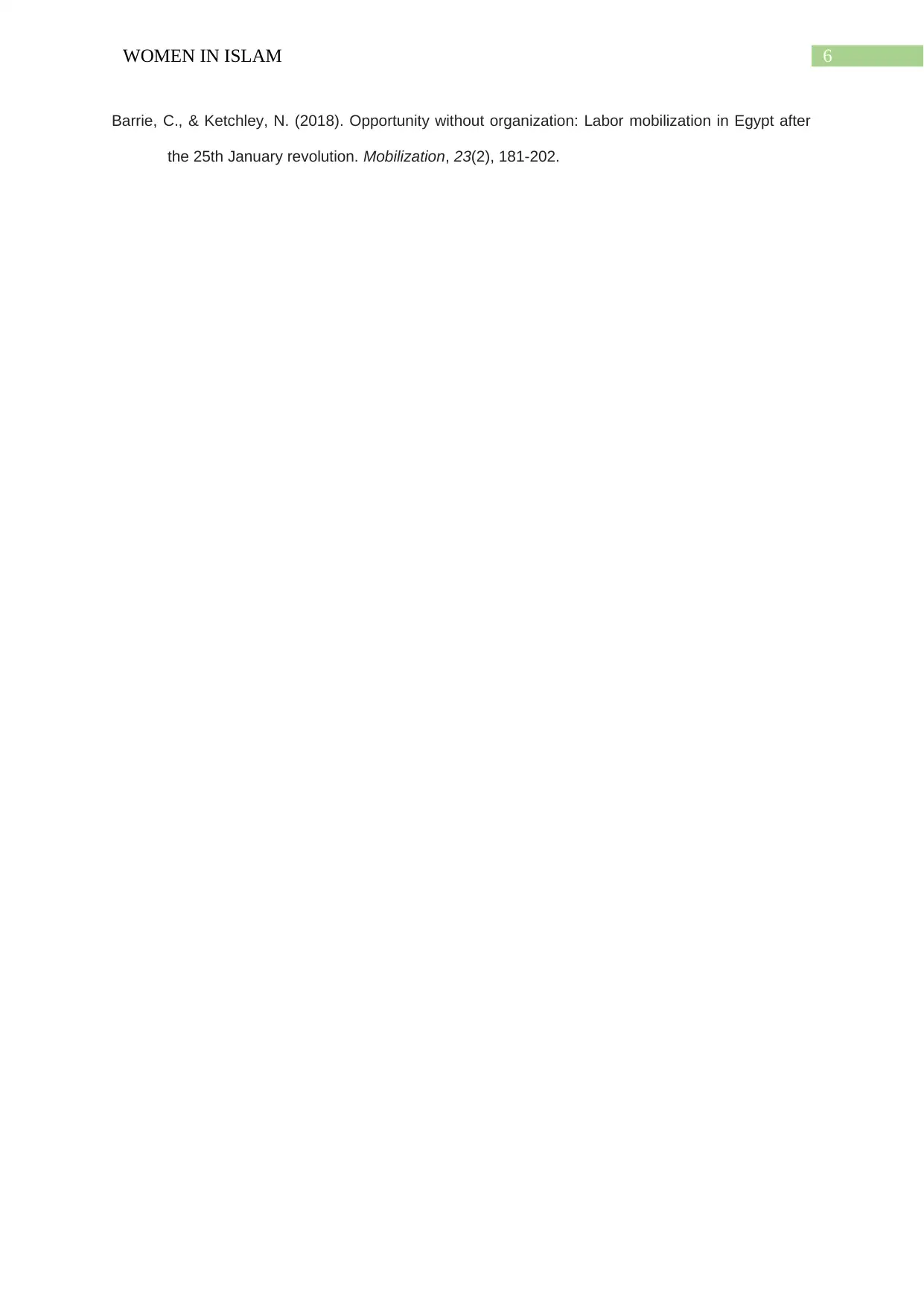
6WOMEN IN ISLAM
Barrie, C., & Ketchley, N. (2018). Opportunity without organization: Labor mobilization in Egypt after
the 25th January revolution. Mobilization, 23(2), 181-202.
Barrie, C., & Ketchley, N. (2018). Opportunity without organization: Labor mobilization in Egypt after
the 25th January revolution. Mobilization, 23(2), 181-202.
1 out of 7
Related Documents
Your All-in-One AI-Powered Toolkit for Academic Success.
+13062052269
info@desklib.com
Available 24*7 on WhatsApp / Email
![[object Object]](/_next/static/media/star-bottom.7253800d.svg)
Unlock your academic potential
© 2024 | Zucol Services PVT LTD | All rights reserved.





